Converting retired school buses into functional greenhouses represents an innovative approach to sustainable agriculture and urban farming. These mobile growing spaces offer unique advantages including affordability, mobility, weather protection, and year-round cultivation potential. From basic hydroponic setups to advanced automated systems, school bus greenhouses can accommodate diverse growing methods while maximizing limited space. Whether designed for educational purposes, commercial production, or personal use, these converted vehicles provide controlled environments that extend growing seasons and protect crops from harsh weather conditions.
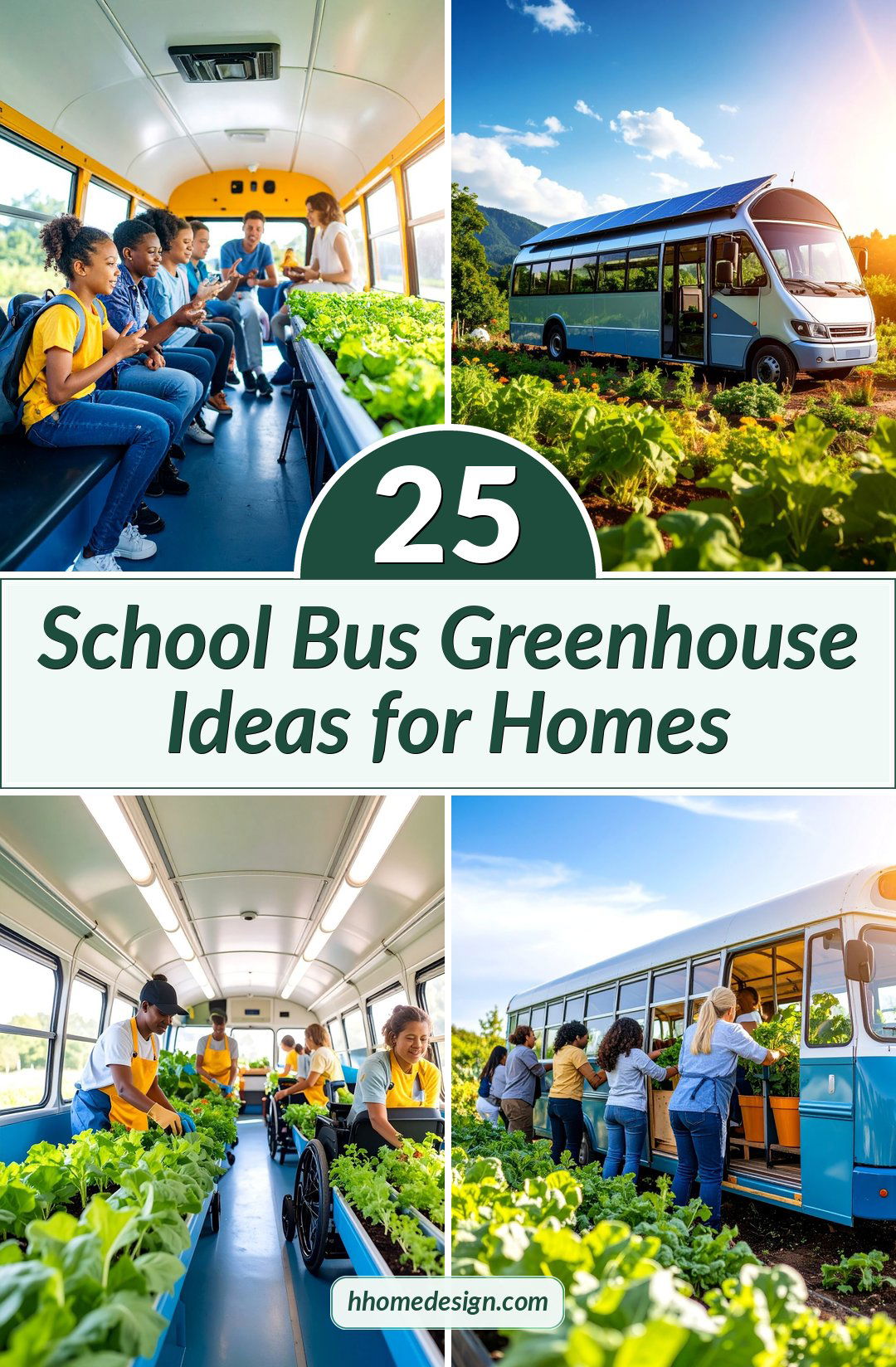
1. Mobile Hydroponic School Bus Greenhouse

This design transforms a 32-passenger school bus into a fully mobile hydroponic growing system while maintaining the original drivetrain for transportation. The interior features three levels of NFT (Nutrient Film Technique) channels running along both sides of the bus, with a central walkway for easy access. LED grow lights provide supplemental lighting during transport and cloudy conditions. A compact water reservoir and nutrient delivery system occupy the rear section, while solar panels on the roof power circulation pumps and monitoring equipment. This mobile setup allows farmers to transport fresh produce directly to markets.
2. Aquaponics School Bus Greenhouse with Fish Tanks

A full-size school bus conversion featuring an integrated aquaponics system that combines fish farming with vegetable production. Large food-grade tanks house tilapia or other suitable fish species, while their waste provides natural fertilizer for plants grown in media beds filled with expanded clay pellets. The system includes biofilters for water purification and automatic feeding mechanisms for the fish. Temperature control maintains optimal conditions for both fish and plants year-round. This closed-loop system maximizes resource efficiency while producing both protein and vegetables in a sustainable, self-contained environment within the bus structure.
3. Vertical Tower School Bus Greenhouse
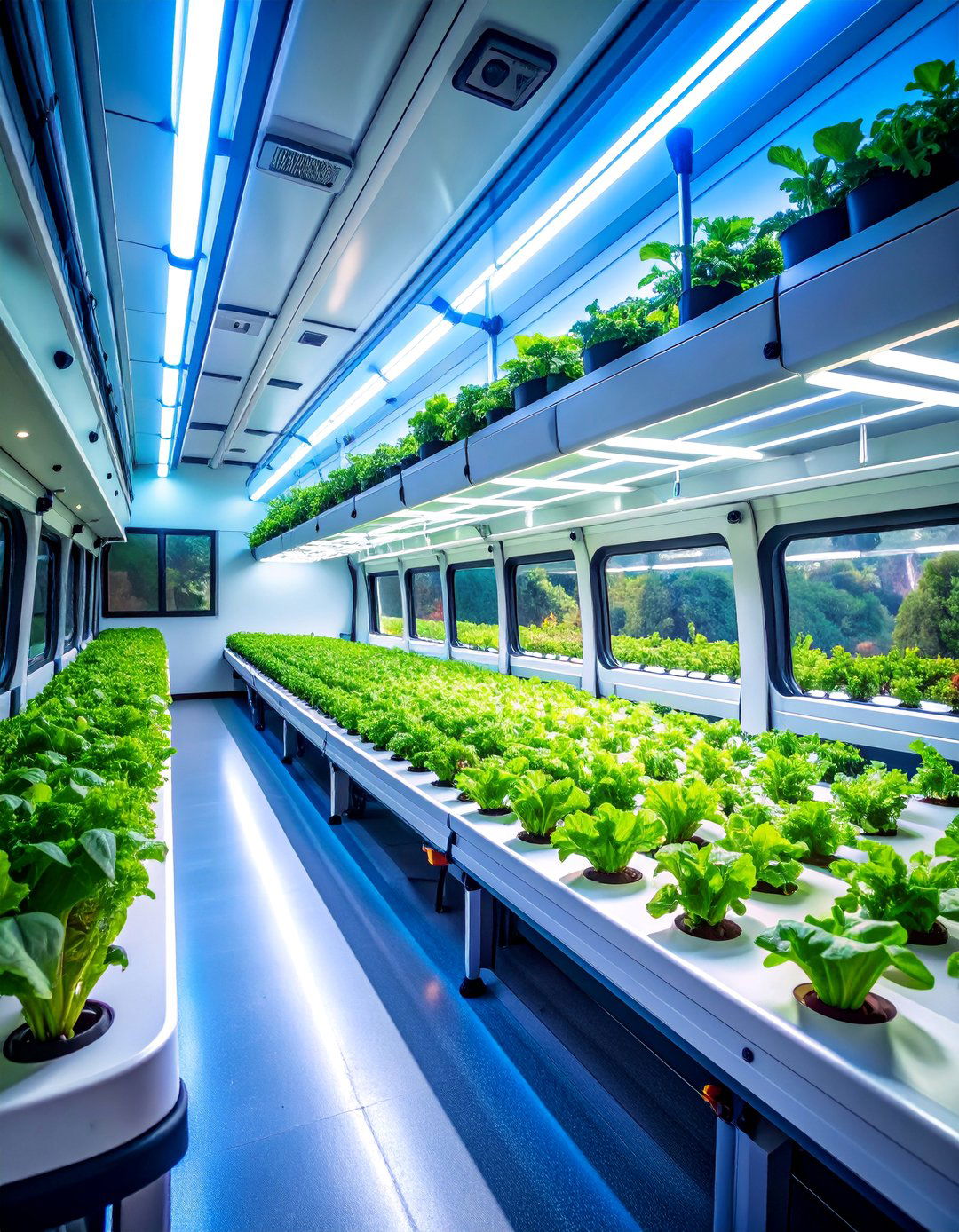
This innovative design maximizes growing space by installing vertical hydroponic towers throughout a converted school bus interior. Aeroponic tower systems allow plants to grow in stacked arrangements, dramatically increasing yield per square foot. The towers feature automated misting systems that deliver nutrients directly to exposed root systems every few minutes. LED lighting arrays provide full-spectrum illumination for photosynthesis, while climate control systems maintain optimal temperature and humidity levels. This space-efficient approach enables commercial-scale production of leafy greens, herbs, and strawberries within the compact bus footprint, perfect for urban farming operations.
4. Climate-Controlled School Bus Greenhouse with Automation
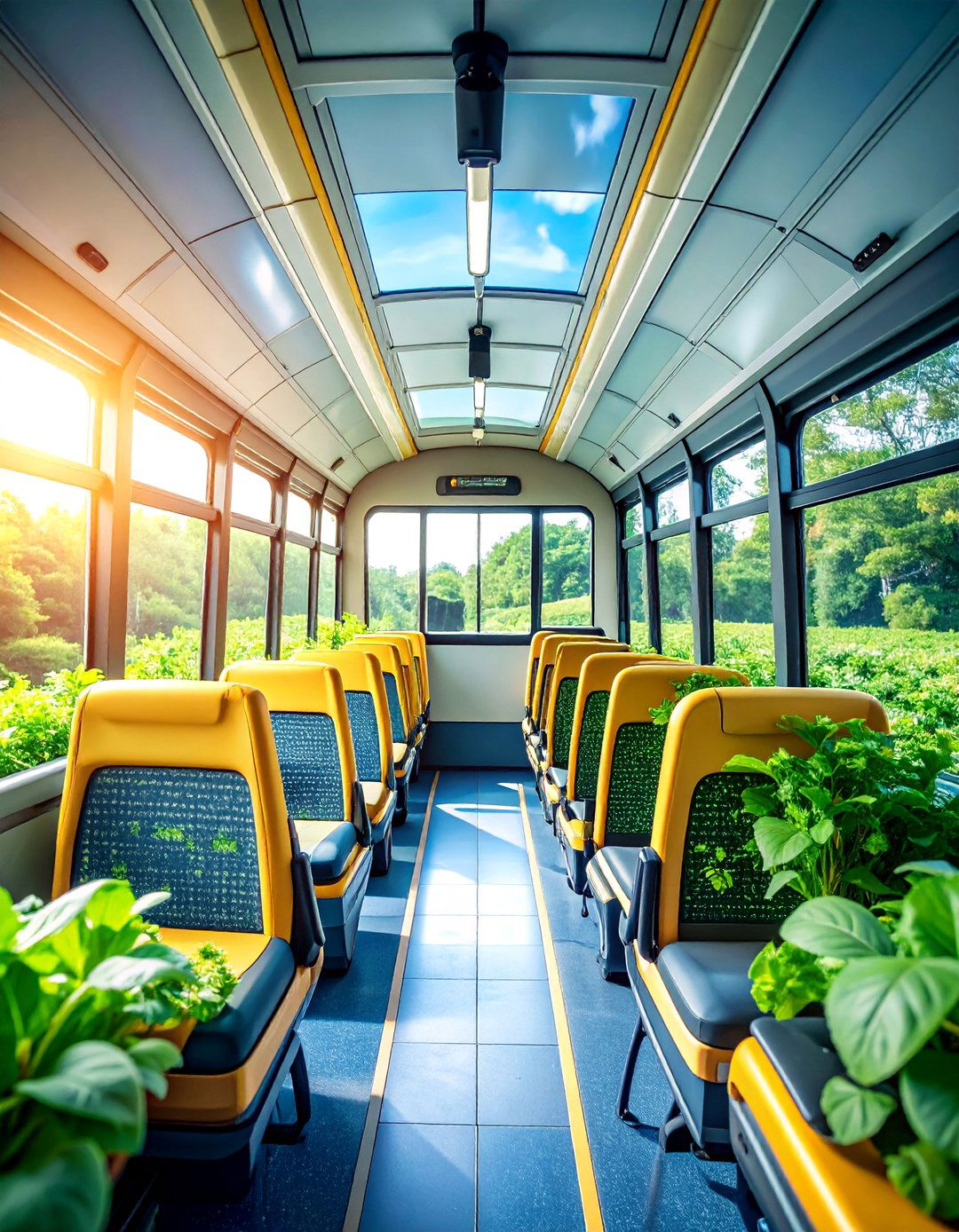
A technologically advanced school bus greenhouse featuring comprehensive climate automation systems that monitor and adjust environmental conditions automatically. Smart sensors continuously track temperature, humidity, CO2 levels, and soil moisture, while computer-controlled systems manage heating, cooling, ventilation, and irrigation. The automated fertigation system delivers precise nutrient solutions based on plant needs and growth stages. Remote monitoring capabilities allow operators to oversee operations via smartphone apps from anywhere. This high-tech approach ensures optimal growing conditions while minimizing labor requirements and maximizing crop yields through precise environmental control.
5. Educational STEAM School Bus Greenhouse
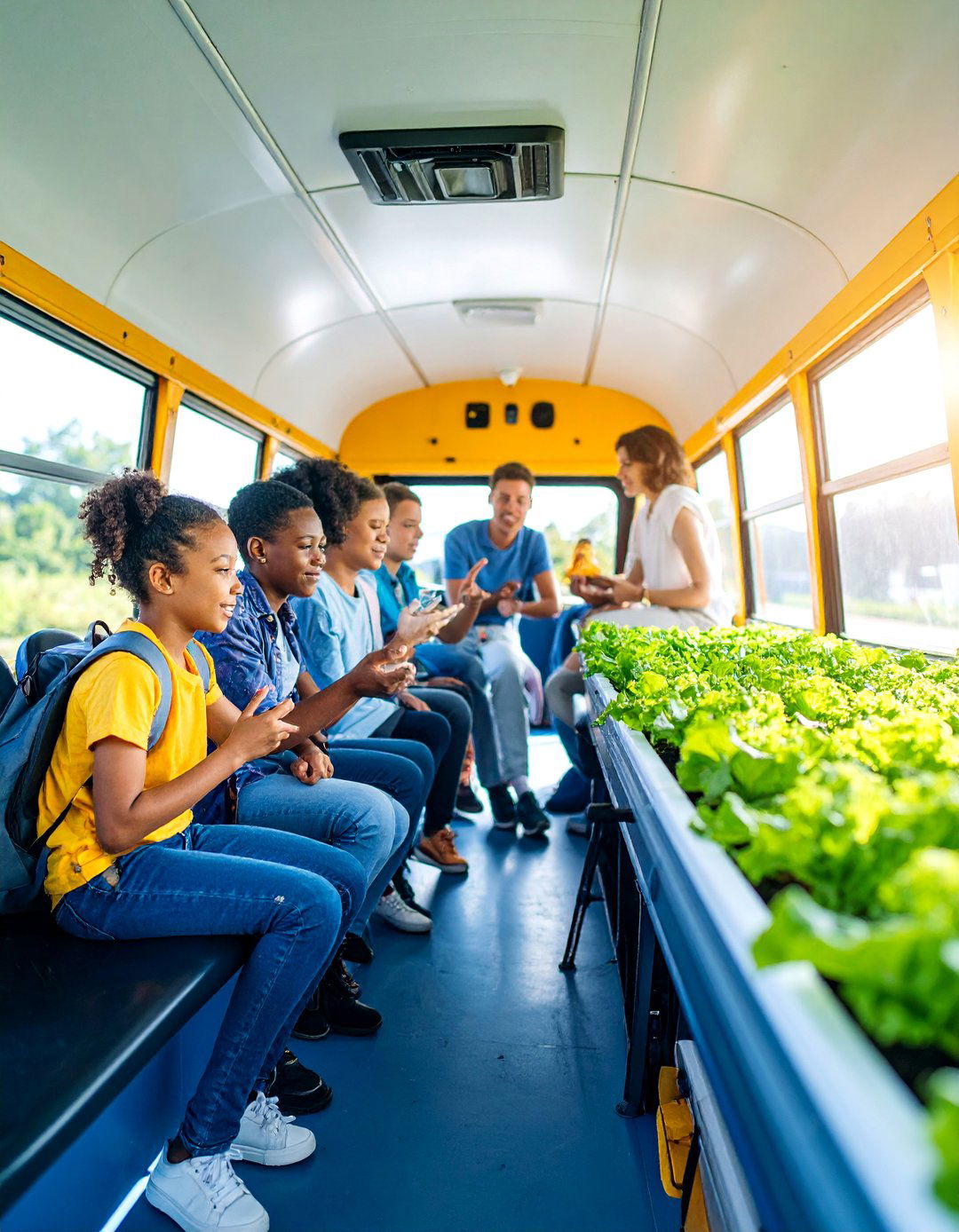
Designed specifically for educational institutions, this school bus greenhouse serves as a living laboratory for STEAM (Science, Technology, Engineering, Arts, Mathematics) curriculum integration. Students learn about plant biology, environmental science, hydroponics, and sustainable agriculture through hands-on experience. The interior features clearly labeled systems, demonstration areas, and data collection stations where students can monitor plant growth and environmental factors. Interactive displays explain the science behind greenhouse operations, while designated workspace areas allow for experiments and projects. This mobile classroom brings agricultural education directly to schools and community centers.
6. Solar-Powered School Bus Greenhouse
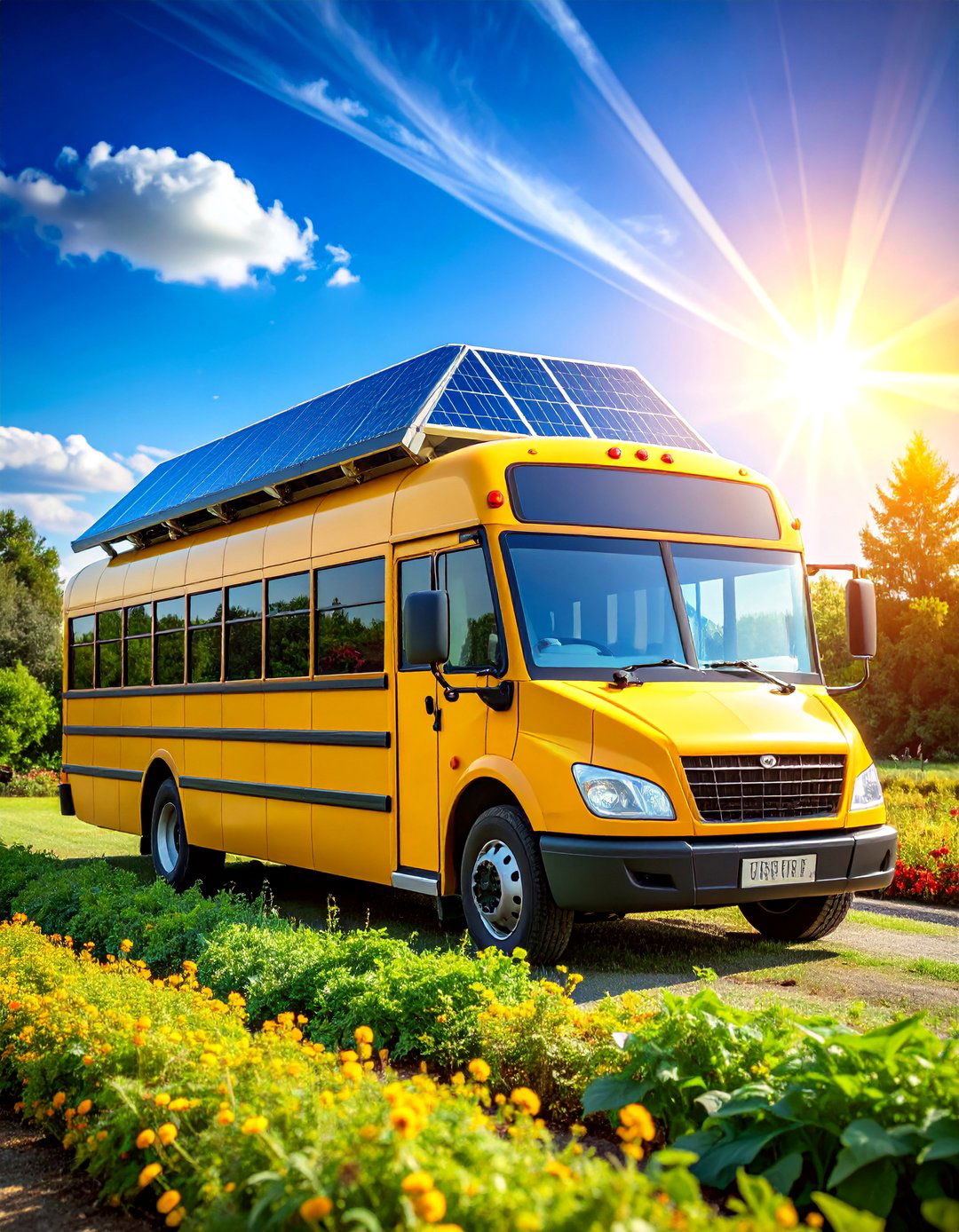
This eco-friendly design incorporates extensive solar panel arrays on the roof and sides of the school bus to create a completely off-grid growing system. High-efficiency photovoltaic panels generate electricity for LED lighting, water pumps, fans, and climate control equipment. Battery storage systems provide power during nighttime hours and cloudy periods. The greenhouse features energy-efficient hydroponic systems and smart controllers that optimize power consumption. Solar water heating systems warm the nutrient solutions and maintain optimal growing temperatures. This sustainable approach demonstrates renewable energy integration while providing fresh produce without relying on traditional power sources.
7. Microgreens Production School Bus Greenhouse

Specifically optimized for high-volume microgreens production, this school bus conversion features multiple growing trays arranged on adjustable shelving systems throughout the interior. Specialized LED lighting provides the optimal spectrum for rapid germination and growth of various microgreen varieties including arugula, radish, pea shoots, and sunflower greens. Climate control maintains consistent temperature and humidity for uniform growth, while automated watering systems ensure proper moisture levels. The design includes harvesting stations, packaging areas, and refrigeration units for post-harvest handling. This commercial-focused approach enables year-round production of premium microgreens for restaurants and farmers markets.
8. Mushroom Cultivation School Bus Greenhouse
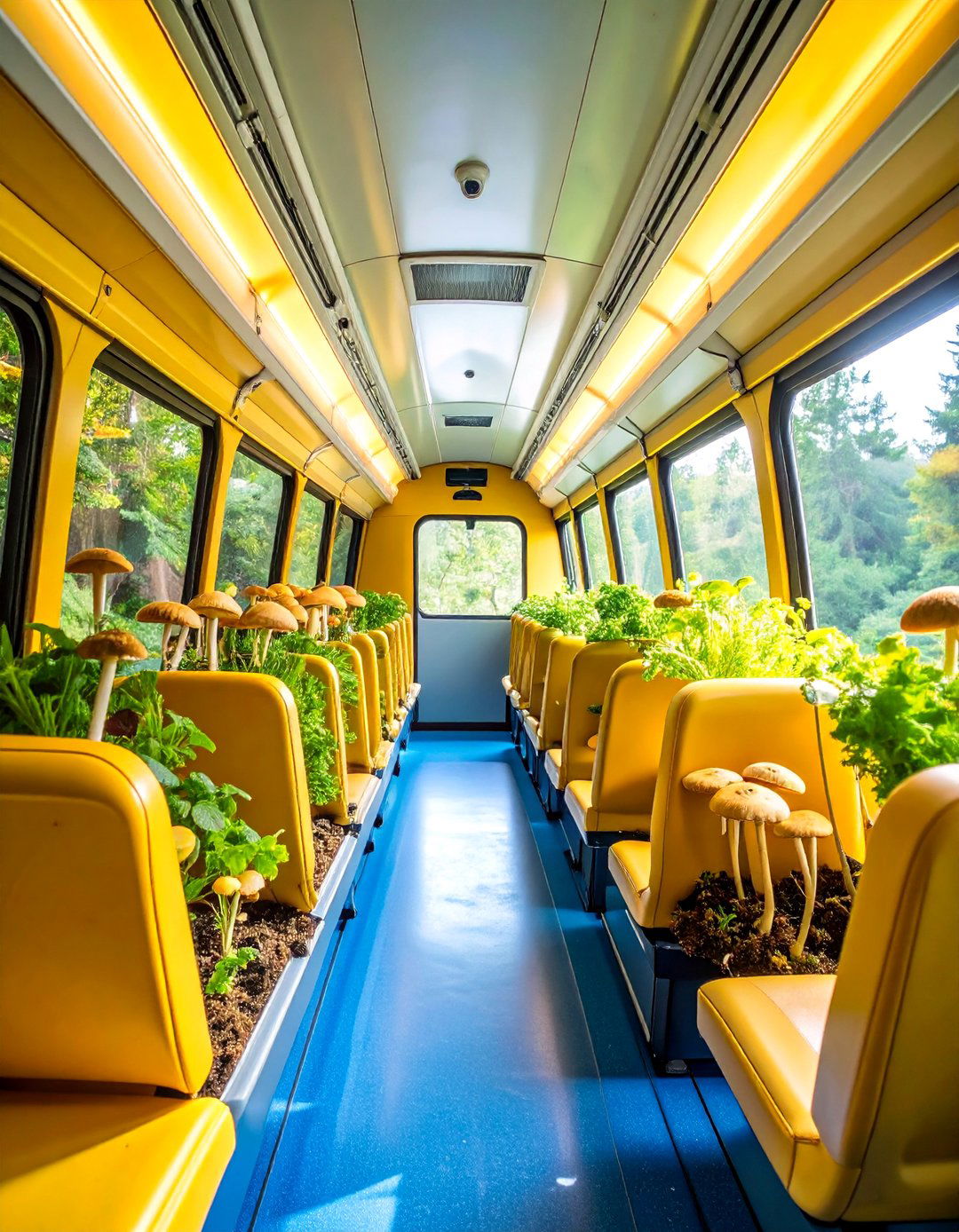
This unique conversion specializes in mushroom cultivation using controlled environment growing methods within a repurposed school bus. The interior features multiple growing chambers with specialized substrates and climate controls that maintain optimal conditions for various mushroom species including oyster, shiitake, and lion's mane mushrooms. Humidity control systems create the moist environment necessary for fungal growth, while filtration systems maintain air quality. Temperature zones accommodate different mushroom varieties with specific growing requirements. This specialized application demonstrates alternative agricultural uses for school bus conversions while meeting growing demand for locally produced gourmet mushrooms.
9. Hydroponic Tomato School Bus Greenhouse
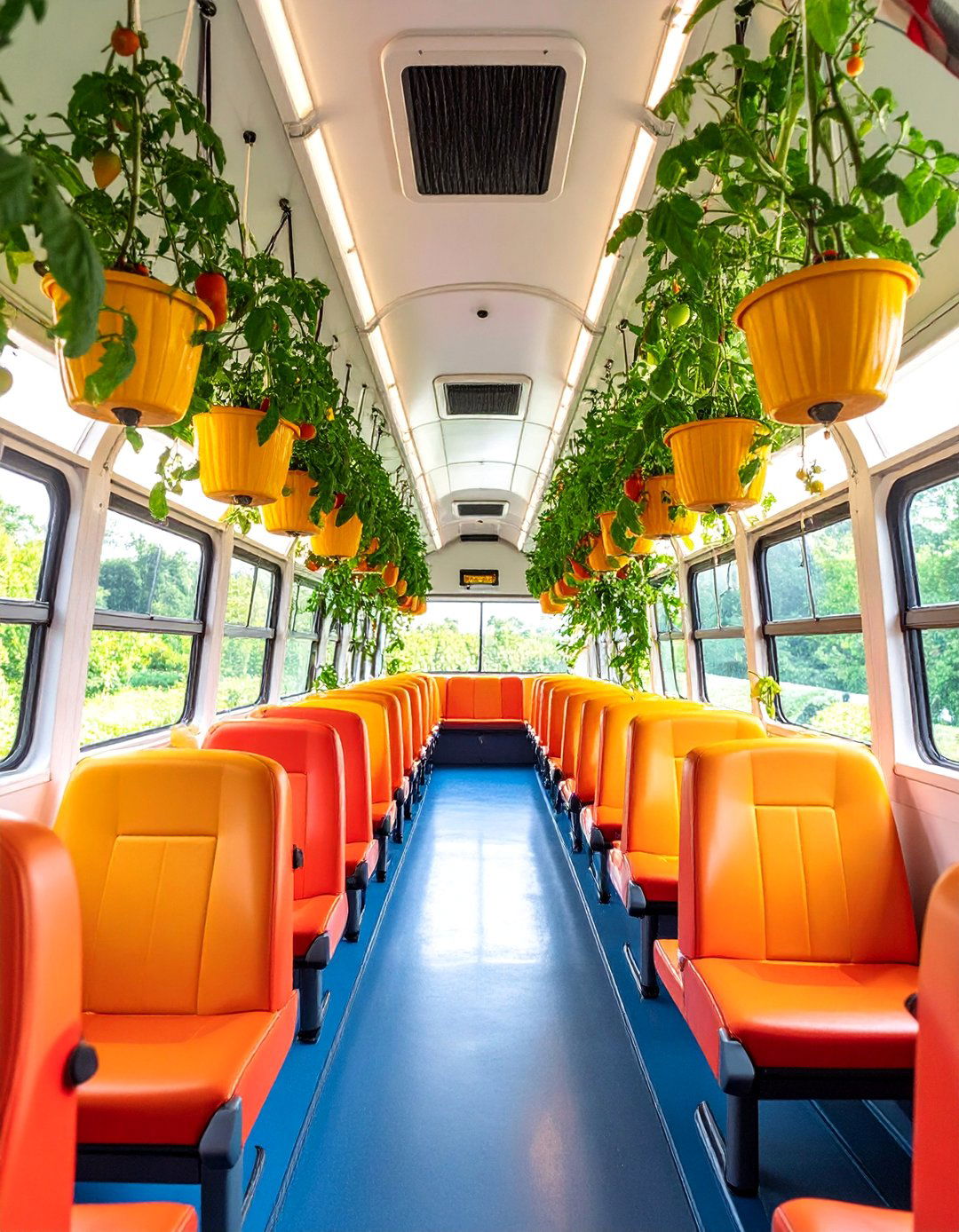
Designed specifically for tomato production, this school bus greenhouse features a Dutch bucket hydroponic system optimized for vine crops. Individual growing containers provide adequate root space for indeterminate tomato varieties, while trellis systems support vertical plant growth up to the bus ceiling. Automated nutrient delivery systems provide precise fertilization schedules throughout the growing season. Climate control maintains optimal temperatures for fruit set and development, while adequate ventilation prevents disease issues. The design includes harvest stations and storage areas for tools and supplies. This specialized approach enables year-round tomato production with yields comparable to traditional greenhouse operations.
10. Lettuce Production School Bus Greenhouse
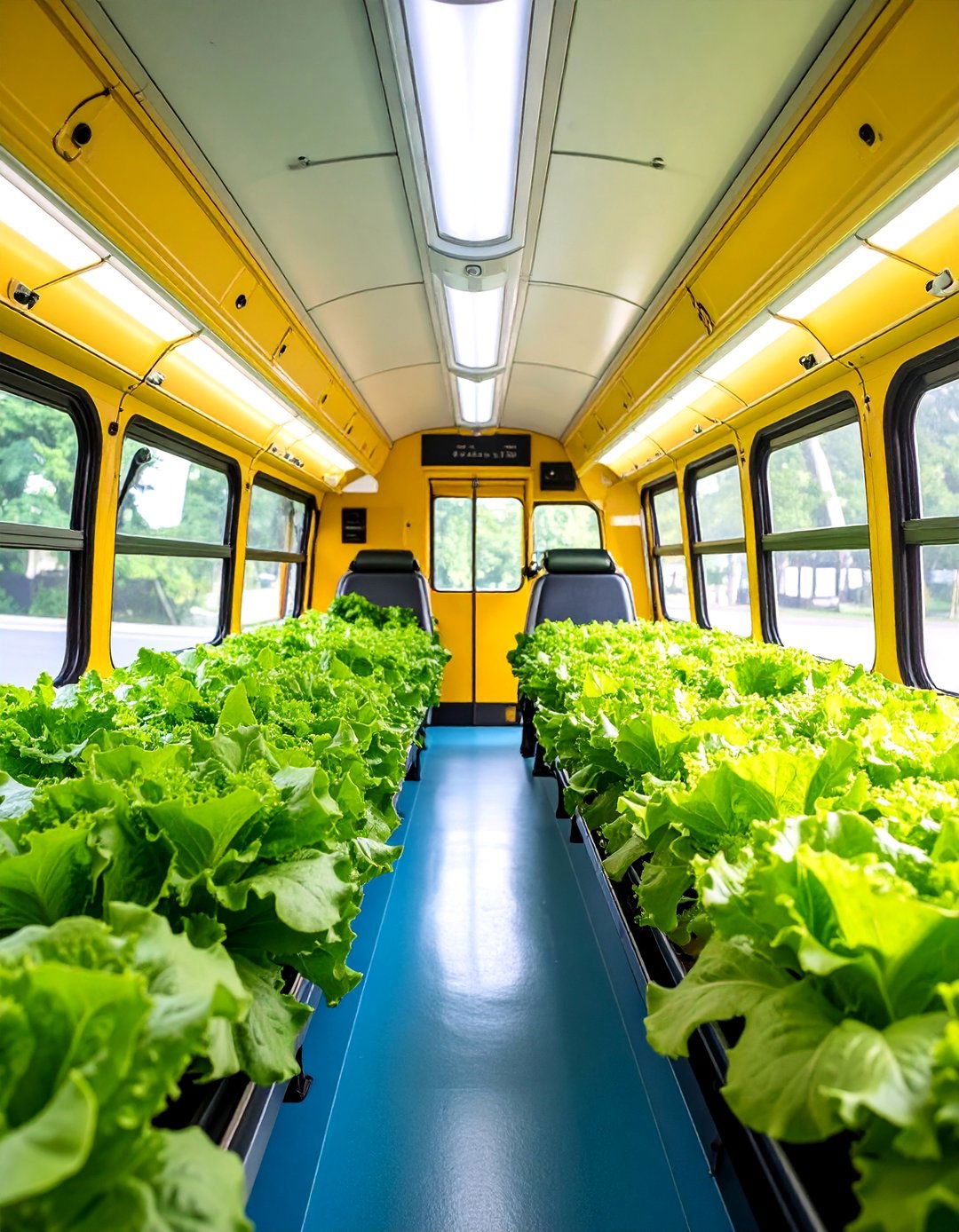
This streamlined design focuses exclusively on lettuce production using deep water culture hydroponic systems. Growing channels filled with nutrient-rich water support various lettuce varieties from seed to harvest in approximately 30 days. LED lighting provides consistent illumination for uniform growth, while air pumps maintain proper oxygen levels in the water. Climate control systems maintain cool temperatures preferred by lettuce crops. The interior layout maximizes growing density while providing easy access for planting, maintenance, and harvesting operations. This efficient system enables continuous lettuce production cycles with multiple harvests per growing season.
11. Herb Garden School Bus Greenhouse
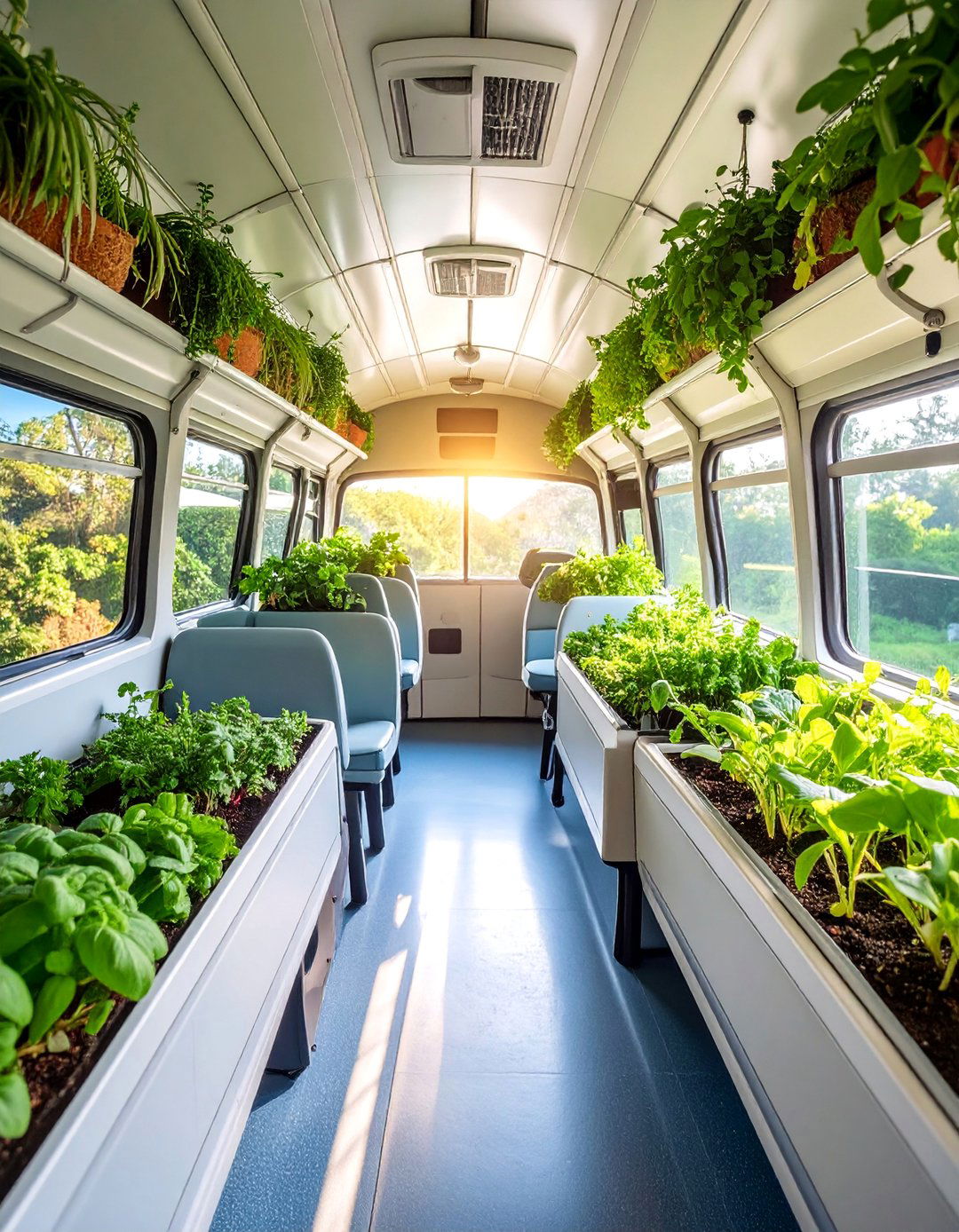
Specifically designed for culinary and medicinal herb production, this school bus greenhouse features diverse growing systems accommodating various herb requirements. Some herbs grow in hydroponic systems while others thrive in soilless growing media that better supports their root systems. Climate zones within the bus accommodate Mediterranean herbs requiring dry conditions and tropical herbs needing higher humidity levels. Essential oil distillation equipment processes herbs for value-added products. The design includes drying areas, processing stations, and storage for harvested herbs. This specialized approach serves restaurants, health food stores, and herbal product manufacturers.
12. Strawberry Production School Bus Greenhouse
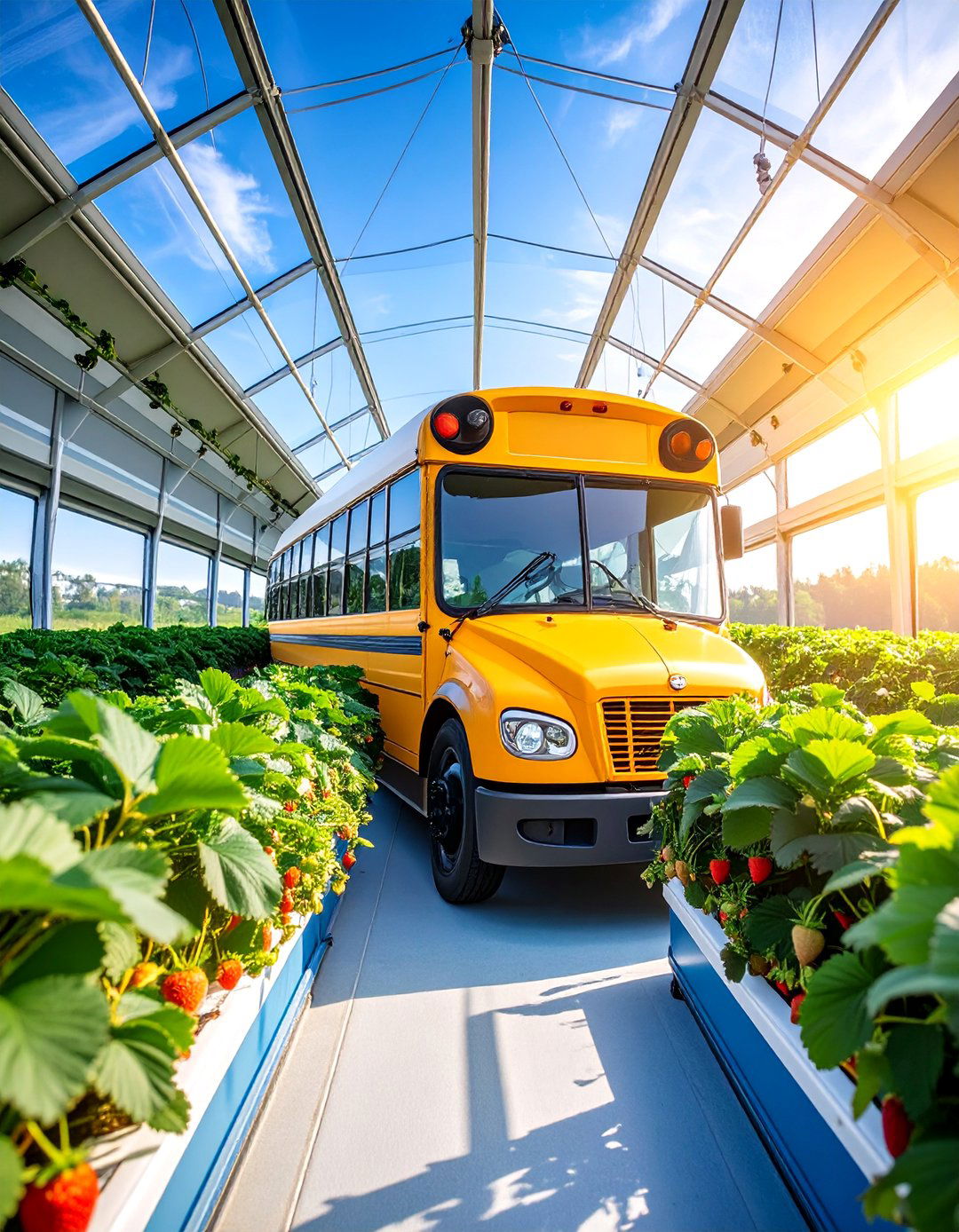
This innovative design optimizes strawberry production using vertical growing towers and specialized hydroponic systems. Everbearing strawberry varieties produce fruit continuously throughout the growing season when provided with optimal conditions. Growing towers maximize planting density while ensuring adequate light penetration to all plants. Automated irrigation delivers nutrients directly to root zones, while climate control maintains temperatures that promote flowering and fruit development. The design includes harvest pathways, fruit washing stations, and refrigerated storage areas. This approach enables fresh strawberry production regardless of outdoor growing seasons, serving local markets with premium fruit.
13. Seed Starting School Bus Greenhouse

Designed as a propagation facility, this school bus greenhouse specializes in starting seeds and growing transplants for outdoor gardens and farms. Multiple germination chambers provide optimal conditions for different seed types, while growing benches accommodate various container sizes. Automated misting systems maintain proper moisture levels during germination, while adjustable LED lighting supports seedling development. Climate control systems create optimal temperatures for root development and plant hardening. The design includes workspace areas for potting, transplanting operations, and storage for growing supplies. This specialized facility serves commercial growers and gardeners requiring reliable transplant production.
14. Research School Bus Greenhouse
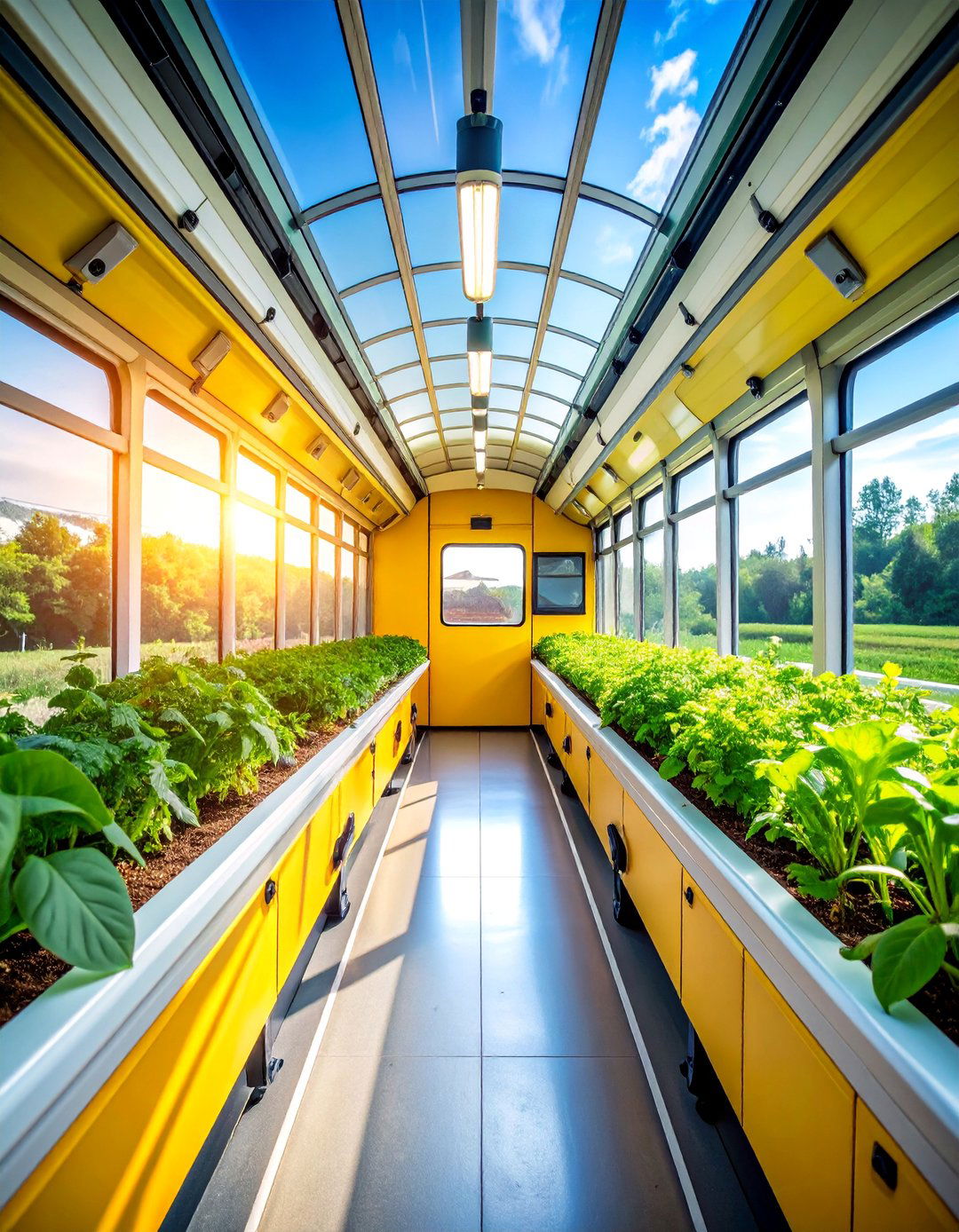
This specialized conversion serves agricultural research institutions and universities conducting plant breeding and crop development studies. Multiple controlled growing environments within the bus allow comparative studies under different conditions. Data logging systems continuously monitor and record environmental parameters and plant responses. Experimental growing systems accommodate various research protocols and testing procedures. Climate control systems provide precise environmental control necessary for replicable research results. The design includes laboratory space for sample analysis, computer stations for data management, and storage for research equipment. This mobile research platform brings advanced agricultural research capabilities to field locations.
15. Community School Bus Greenhouse

Designed for community garden projects and neighborhood food security initiatives, this school bus greenhouse provides shared growing space for multiple families or organizations. Individual growing plots within the bus allow participants to grow their own vegetables while sharing resources and knowledge. Educational signage explains growing techniques and sustainable practices to community members. The design includes meeting spaces for workshops and training sessions, tool storage areas, and demonstration plots showcasing different growing methods. This community-focused approach promotes food security, education, and social connections while providing fresh produce for participants.
16. Pollinator-Friendly School Bus Greenhouse
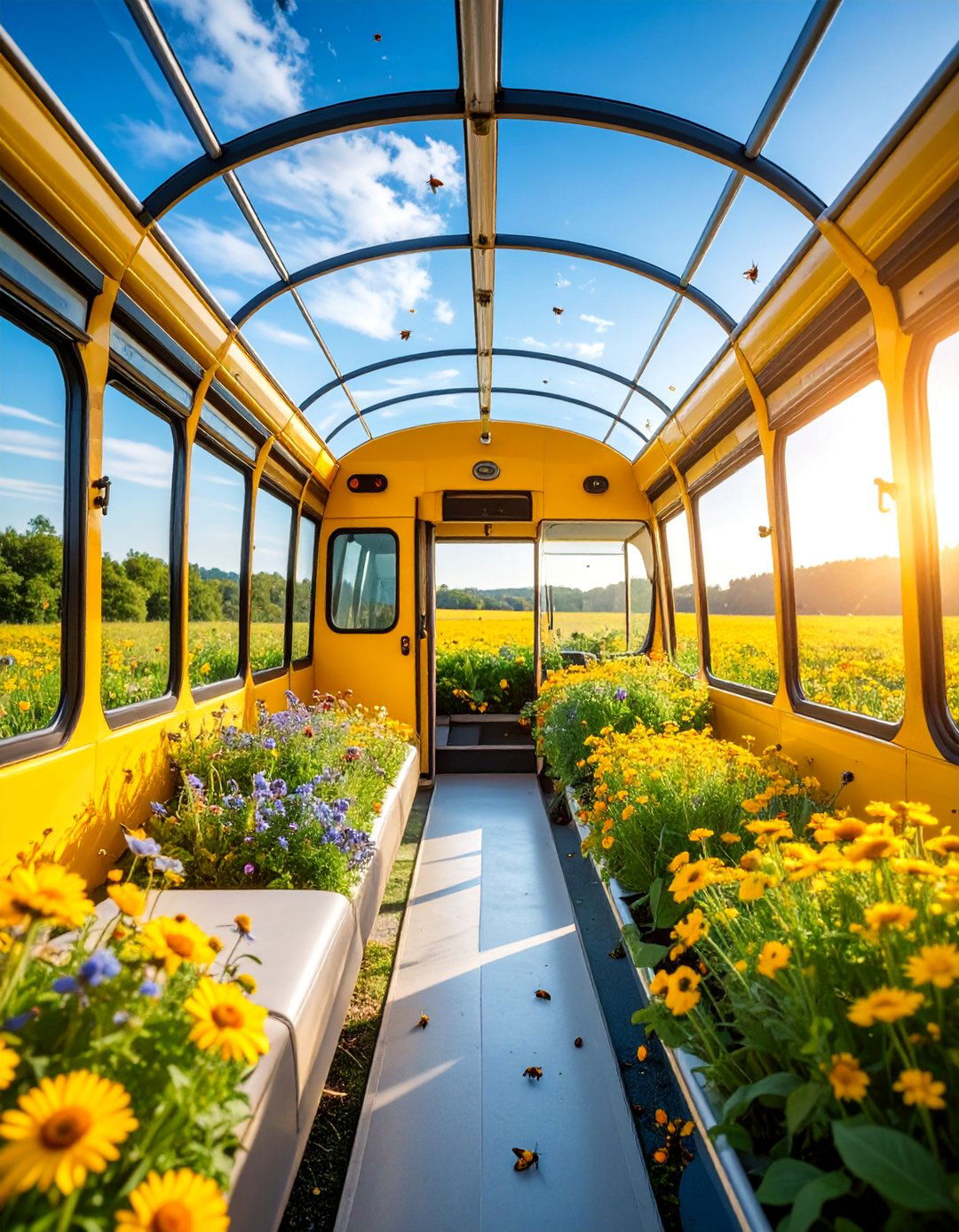
This unique design incorporates pollinator habitat and beneficial insect production alongside vegetable cultivation. Native wildflower growing areas attract bees, butterflies, and other beneficial insects that support both greenhouse crops and surrounding ecosystems. Integrated pest management systems use beneficial insects for natural pest control rather than chemical treatments. The design includes observation areas for studying pollinator behavior and educational displays about pollinator conservation. Climate control systems accommodate both crop production and pollinator habitat requirements. This approach demonstrates sustainable agriculture practices while supporting declining pollinator populations.
17. Winter Growing School Bus Greenhouse
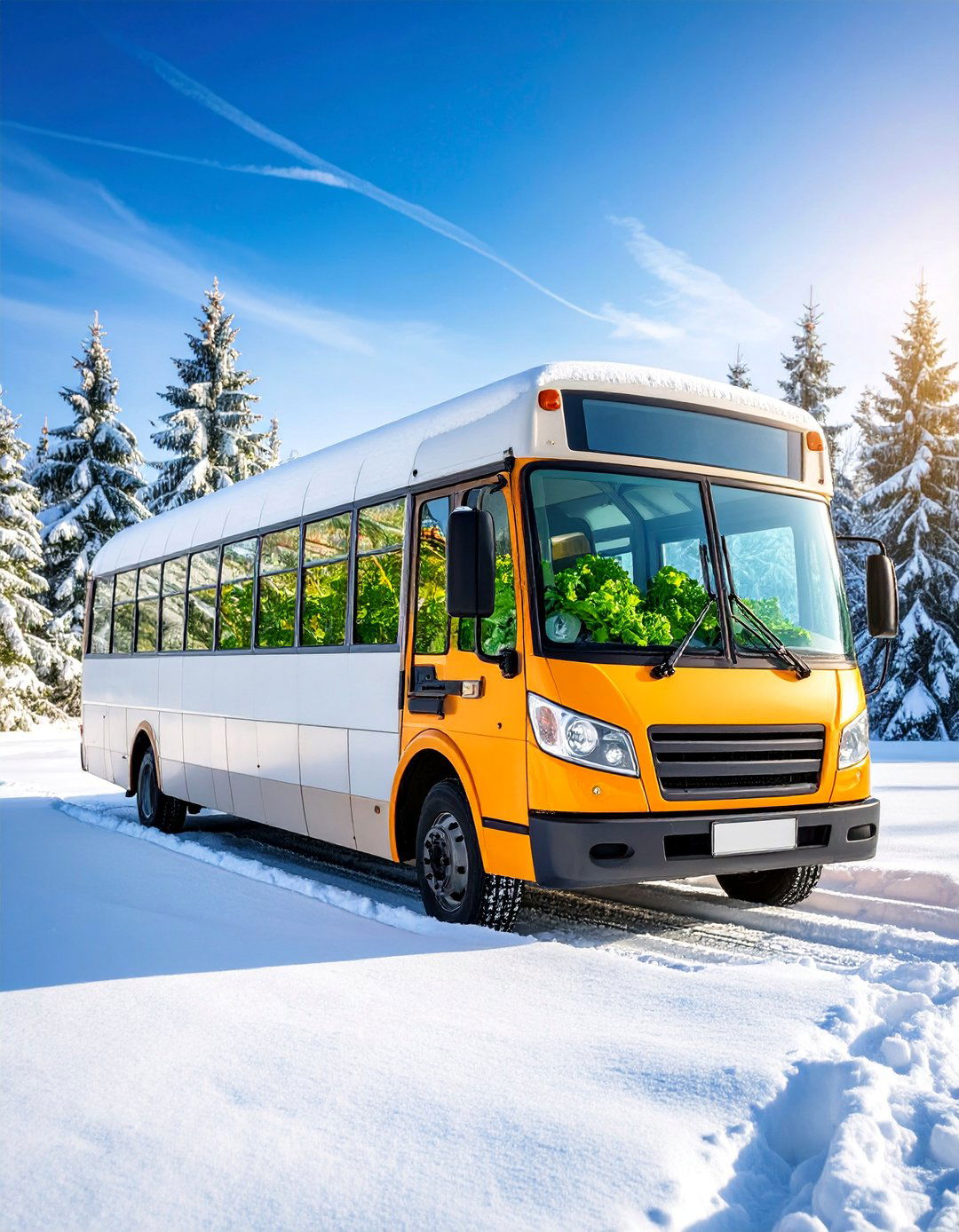
Specifically designed for cold climate operations, this school bus greenhouse enables year-round growing in harsh winter conditions. Enhanced insulation, double-wall construction, and efficient heating systems maintain optimal growing temperatures despite external conditions. Thermal mass systems store solar energy during daylight hours for nighttime heating. Cold-hardy crop varieties and season extension techniques maximize winter production potential. The design includes cold frames, season extension tools, and energy-efficient growing systems. This specialized approach extends growing seasons in northern climates while reducing heating costs through smart design and energy conservation measures.
18. Urban Rooftop School Bus Greenhouse
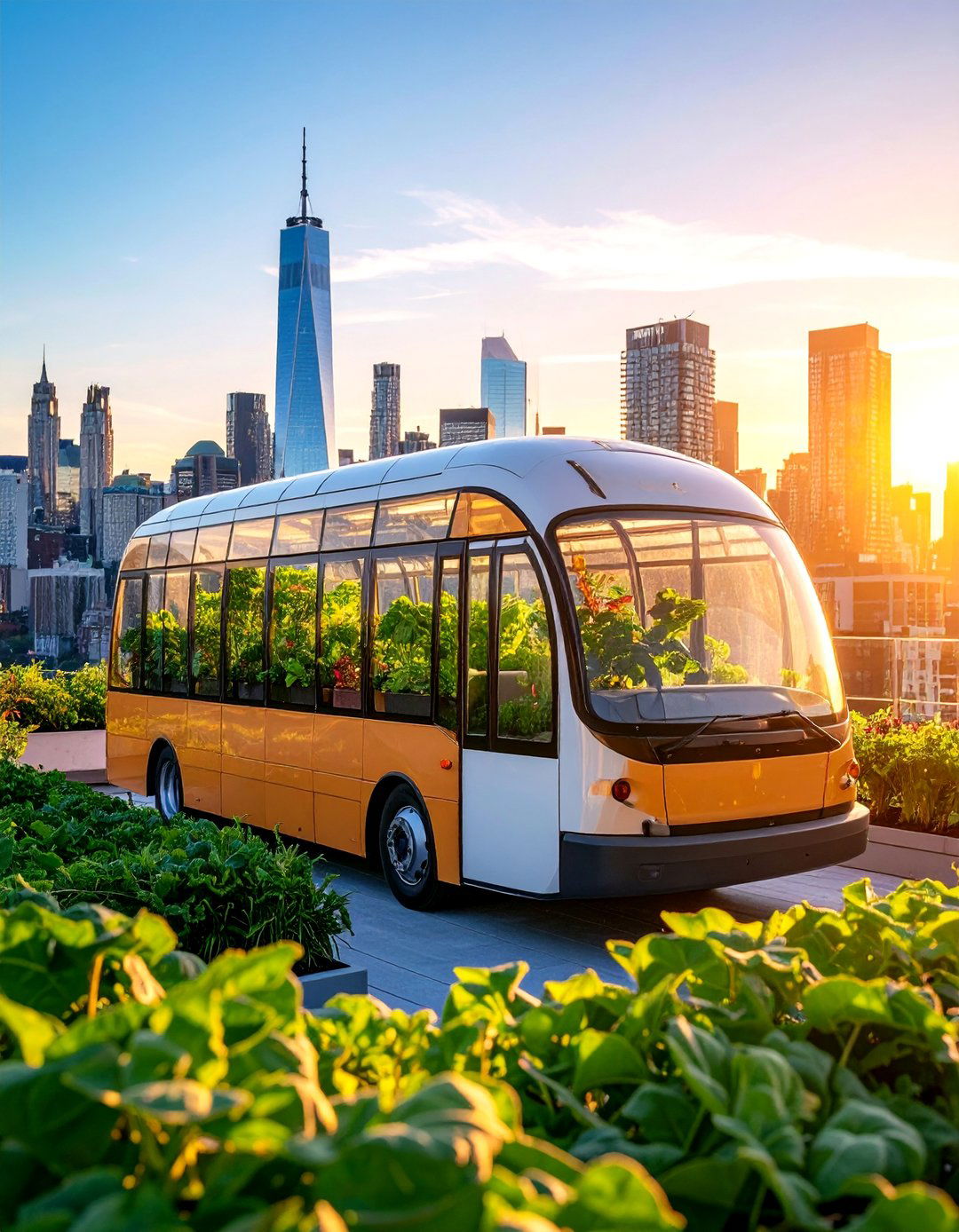
Designed for rooftop installation in urban environments, this school bus greenhouse maximizes growing space in densely populated areas. Structural modifications and foundation systems enable safe rooftop installation while meeting building codes and safety requirements. Wind-resistant design features protect crops and equipment from urban wind conditions. The greenhouse integrates with building systems for power, water, and climate control where possible. Vertical growing systems maximize production in limited space while providing fresh produce for urban residents. This innovative approach brings agriculture to city centers while utilizing unused rooftop space.
19. Off-Grid School Bus Greenhouse
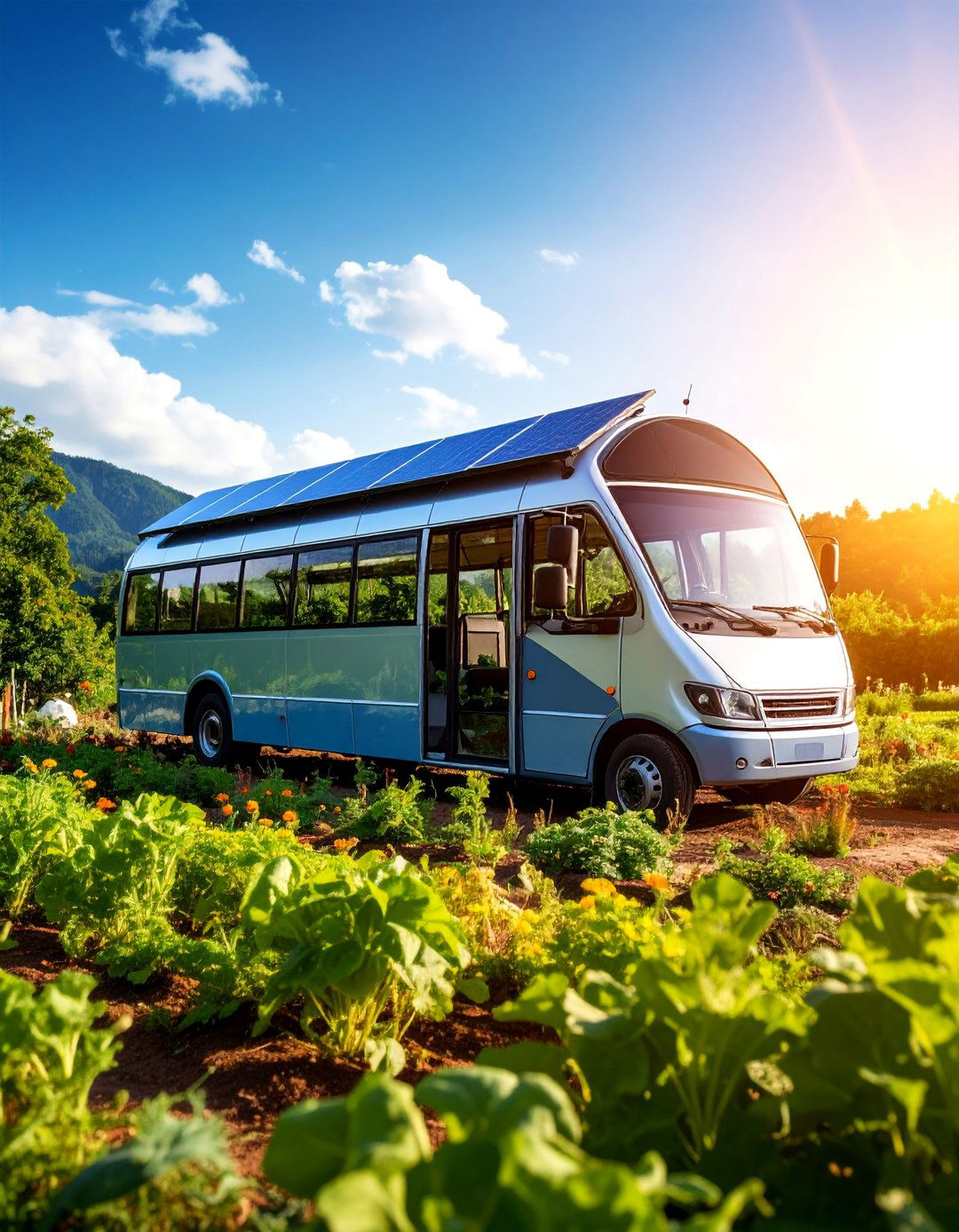
This completely self-sufficient design operates independently without external utilities or infrastructure. Solar panels, wind generators, and battery storage systems provide all electrical power needs. Rainwater collection and filtration systems supply water for irrigation and operations. Composting systems process organic waste into fertilizer for growing operations. The design includes propane heating systems for backup temperature control and manual override systems for all automated functions. This approach enables greenhouse operations in remote locations while demonstrating sustainable living principles and energy independence.
20. Therapeutic School Bus Greenhouse
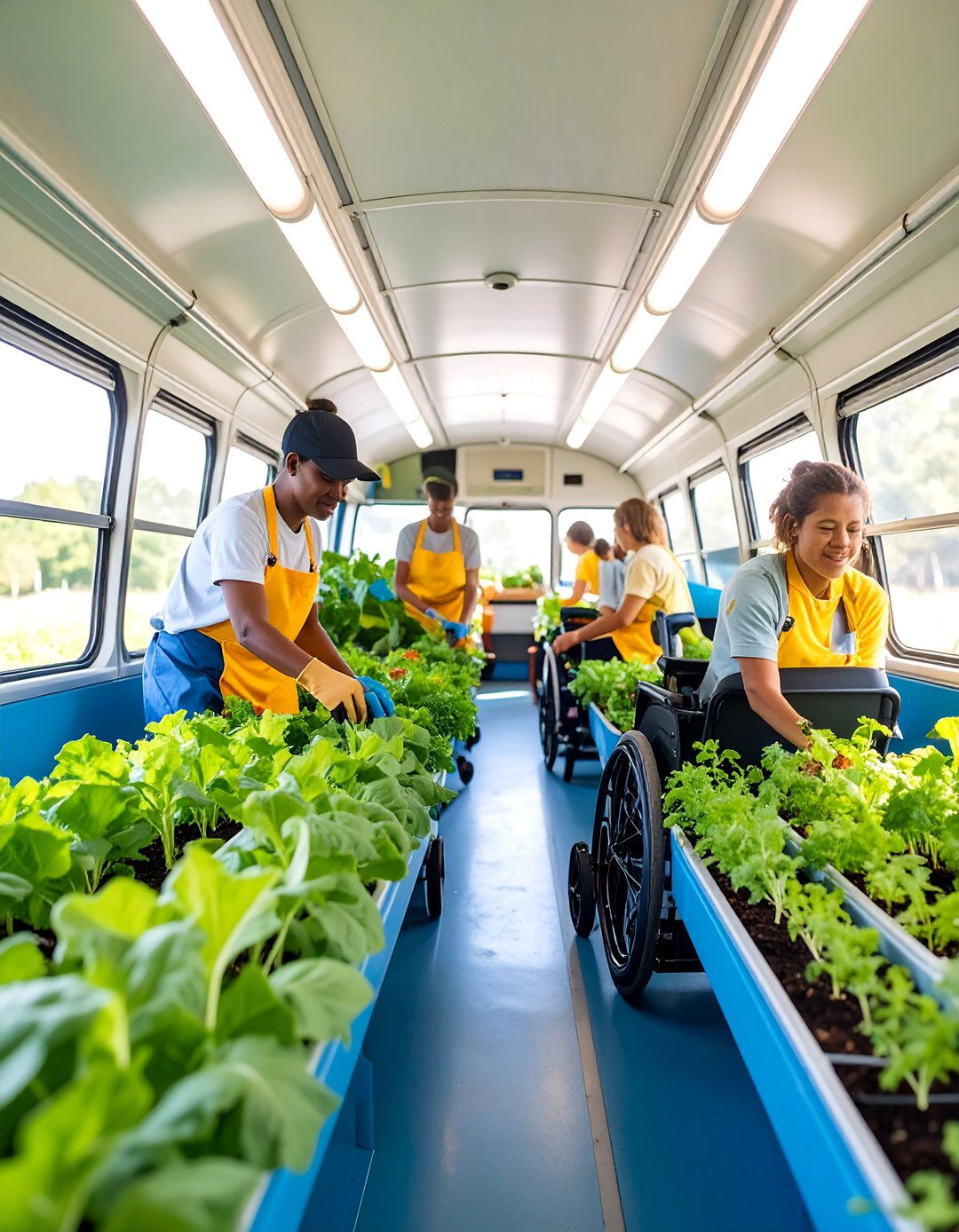
Designed for horticultural therapy programs, this school bus greenhouse provides therapeutic growing experiences for individuals with disabilities, seniors, or those recovering from illness or injury. Raised growing beds accommodate wheelchair access and reduce bending requirements. Adaptive tools and equipment enable participation regardless of physical limitations. Sensory gardens stimulate sight, smell, and touch while providing calming environments. The design includes seating areas, therapeutic activity stations, and accessibility features throughout. This specialized approach uses gardening as therapy while producing fresh vegetables and flowers for participants and their communities.
21. Aquaculture School Bus Greenhouse

This specialized design focuses on fish farming and aquaculture production within a converted school bus environment. Multiple tank systems house different fish species at various life stages, from fingerlings to market-size fish. Water filtration and recirculation systems maintain optimal water quality while conserving this precious resource. Climate control systems regulate water temperature for optimal fish growth and health. The design includes fish processing areas, feed storage, and water quality monitoring equipment. This approach provides sustainable protein production while demonstrating aquaculture techniques and supporting local food systems with fresh fish.
22. Seedbank School Bus Greenhouse
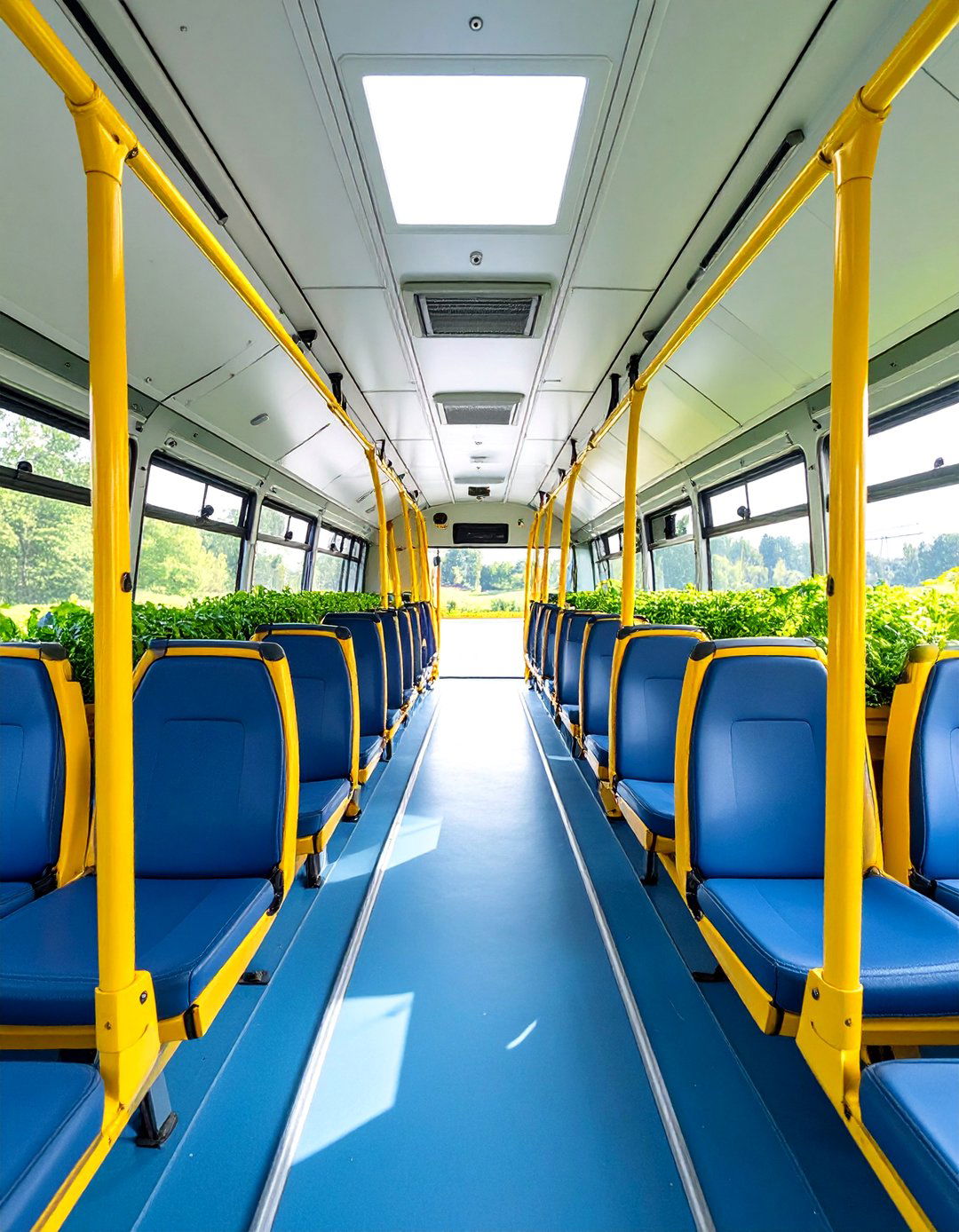
This preservation-focused design serves as a mobile seedbank and genetic conservation facility protecting heirloom and rare plant varieties. Climate-controlled storage areas maintain optimal conditions for long-term seed viability. Growing areas enable seed production and variety maintenance through careful cultivation of parent plants. The design includes seed processing equipment, testing laboratories, and documentation systems for tracking genetic materials. Educational displays explain seed conservation importance and techniques. This specialized approach preserves agricultural biodiversity while providing educational opportunities about plant genetics and conservation efforts.
23. Medicinal Plant School Bus Greenhouse

Specifically designed for growing medicinal herbs and plants, this school bus greenhouse features specialized growing systems accommodating various therapeutic plant requirements. Different climate zones within the bus support plants with diverse environmental needs, from temperate herbs to tropical medicinal plants. The design includes processing areas for preparing herbal remedies, drying chambers for herb preservation, and laboratory space for quality testing. Documentation systems track plant origins, growing conditions, and potency levels. This specialized approach serves alternative medicine practitioners, researchers, and communities interested in traditional healing methods and herbal medicine production.
24. Flower Production School Bus Greenhouse

This aesthetically focused design specializes in cut flower production for florists, farmers markets, and special events. Growing systems accommodate various flower types including annuals, perennials, and bulb flowers. Climate control systems provide optimal conditions for flower development and longevity. The design includes conditioning areas for post-harvest flower care, refrigerated storage for maintaining flower quality, and workspace for arrangement preparation. Specialized lighting enhances flower color and extends vase life. This approach serves the cut flower industry while providing beautiful flowers for communities and demonstrating ornamental horticulture techniques.
25. Integrated Food Production School Bus Greenhouse
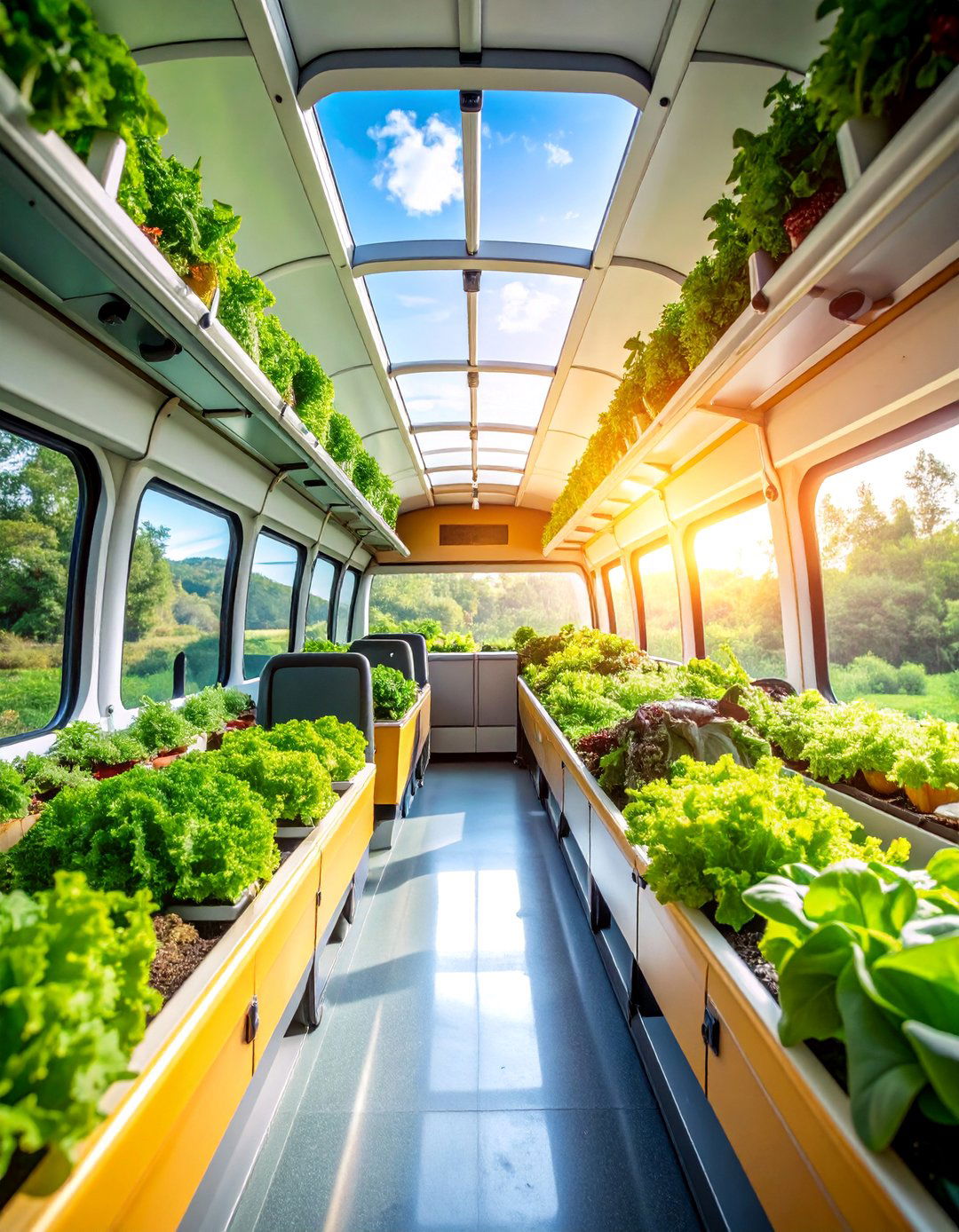
This comprehensive design combines multiple growing systems within a single school bus to maximize food production diversity and efficiency. Different sections accommodate various crops including vegetables, herbs, microgreens, and fruits using appropriate growing methods for each. Aquaponics systems provide fish protein while fertilizing plants, and mushroom cultivation utilizes organic waste materials. The design includes food processing areas, preservation equipment, and storage systems for managing diverse harvests. This integrated approach demonstrates comprehensive food production systems while providing complete nutrition from a single mobile growing facility.
Conclusion:
School bus greenhouse conversions offer innovative solutions for sustainable agriculture, education, and community food production. These versatile growing systems accommodate diverse applications from commercial production to therapeutic programs, demonstrating the potential for creative agricultural solutions. Whether implementing simple hydroponic systems or complex automated environments, converted school buses provide affordable, mobile, and efficient growing spaces that extend seasons and protect crops while serving communities with fresh, locally grown produce.




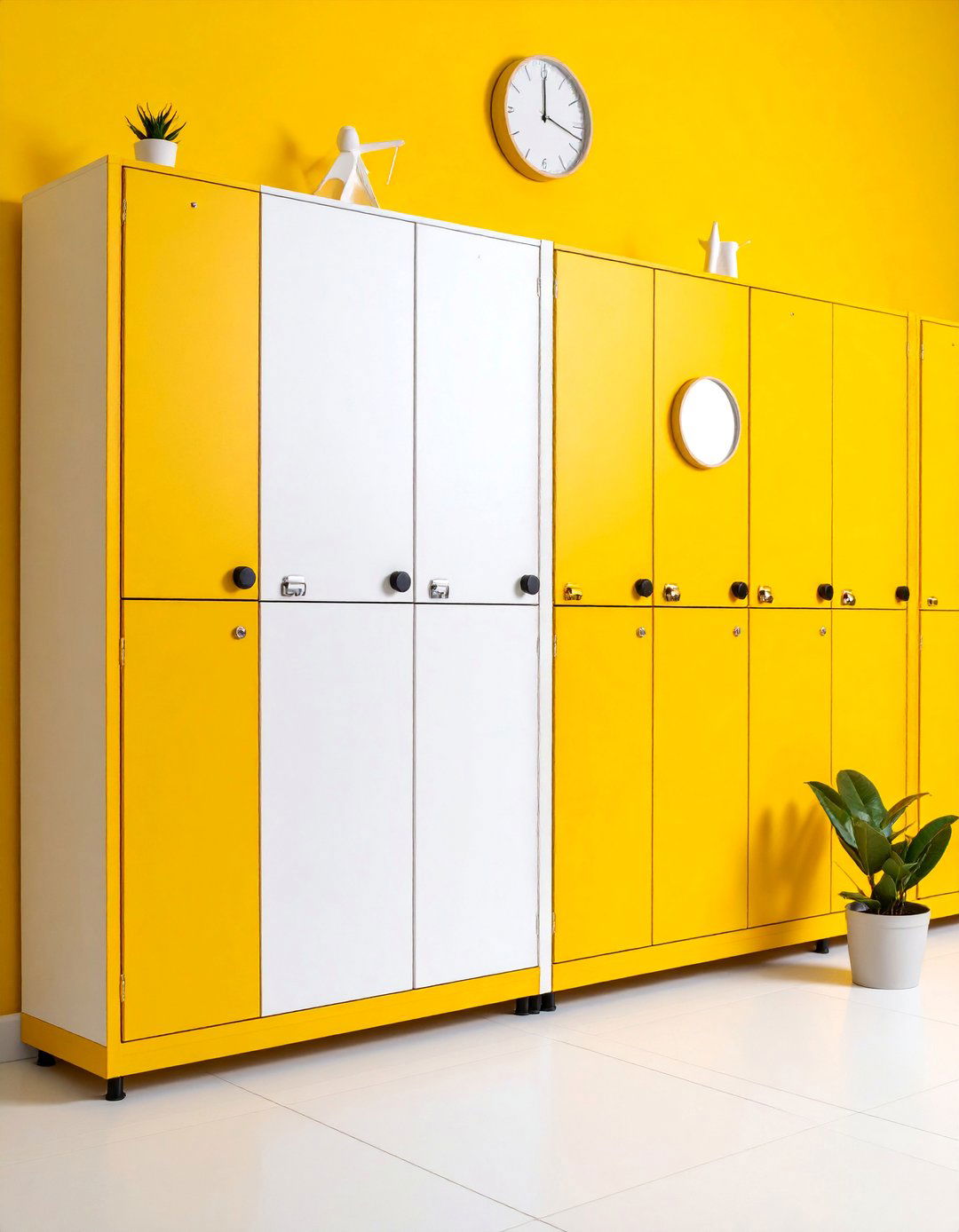
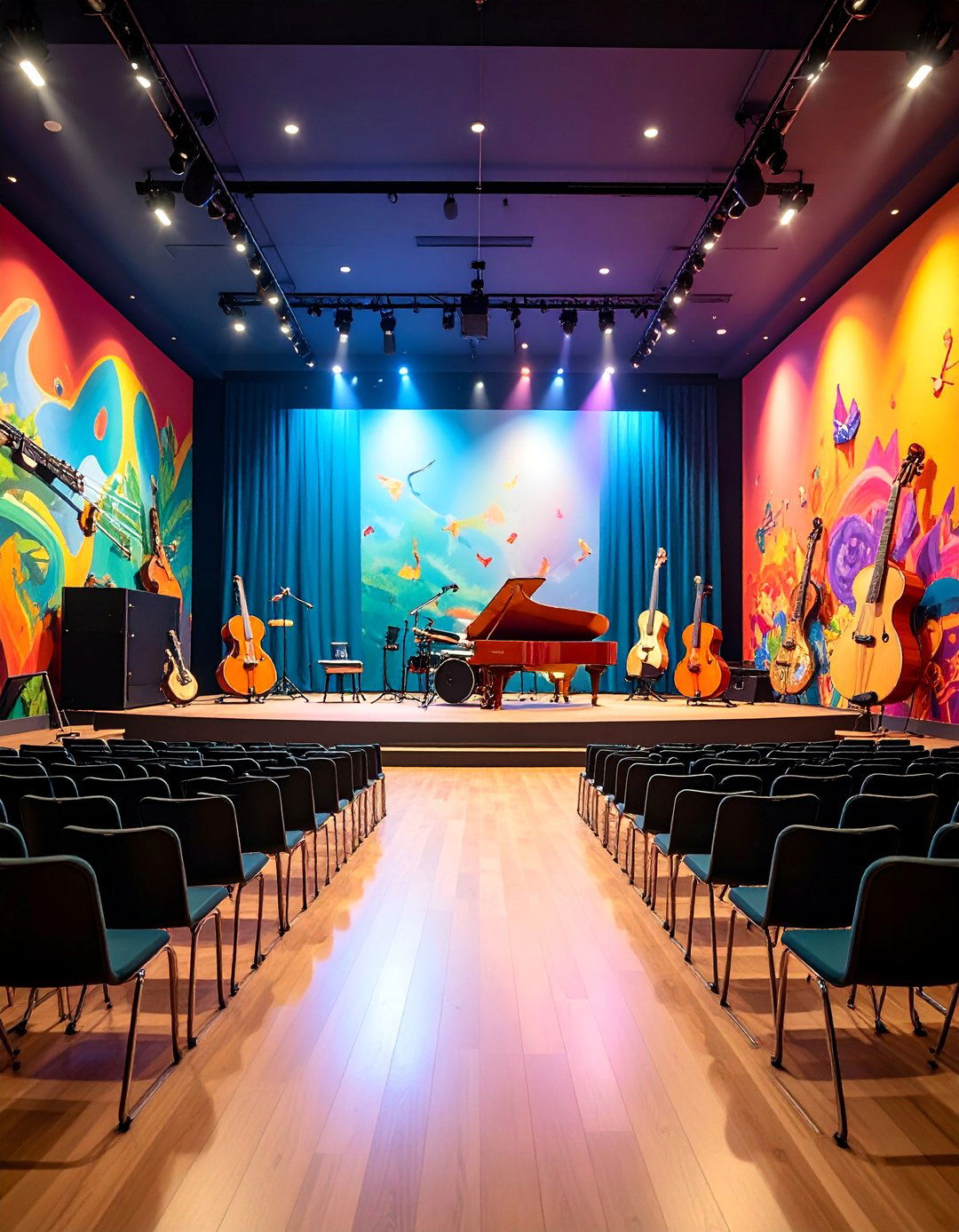

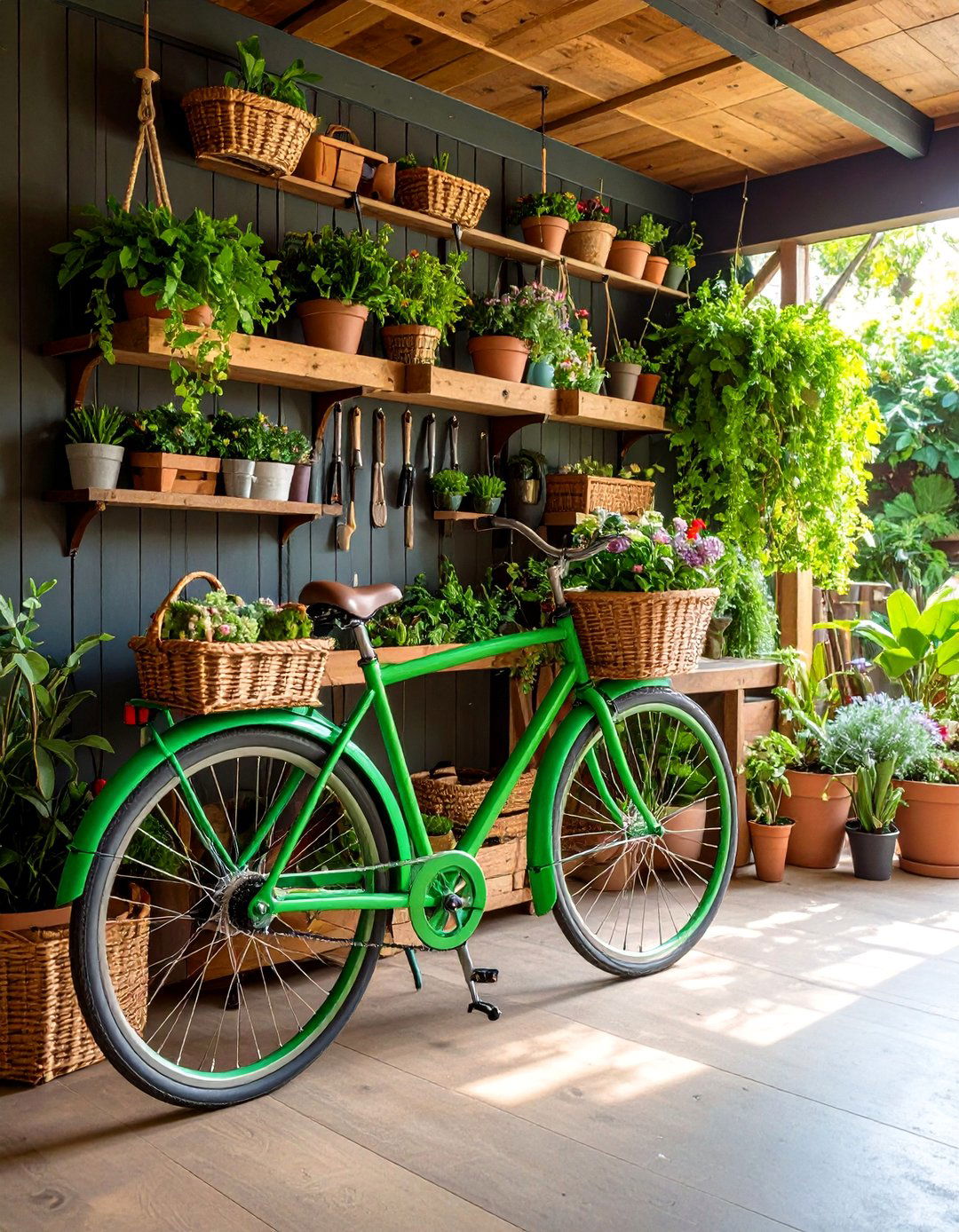
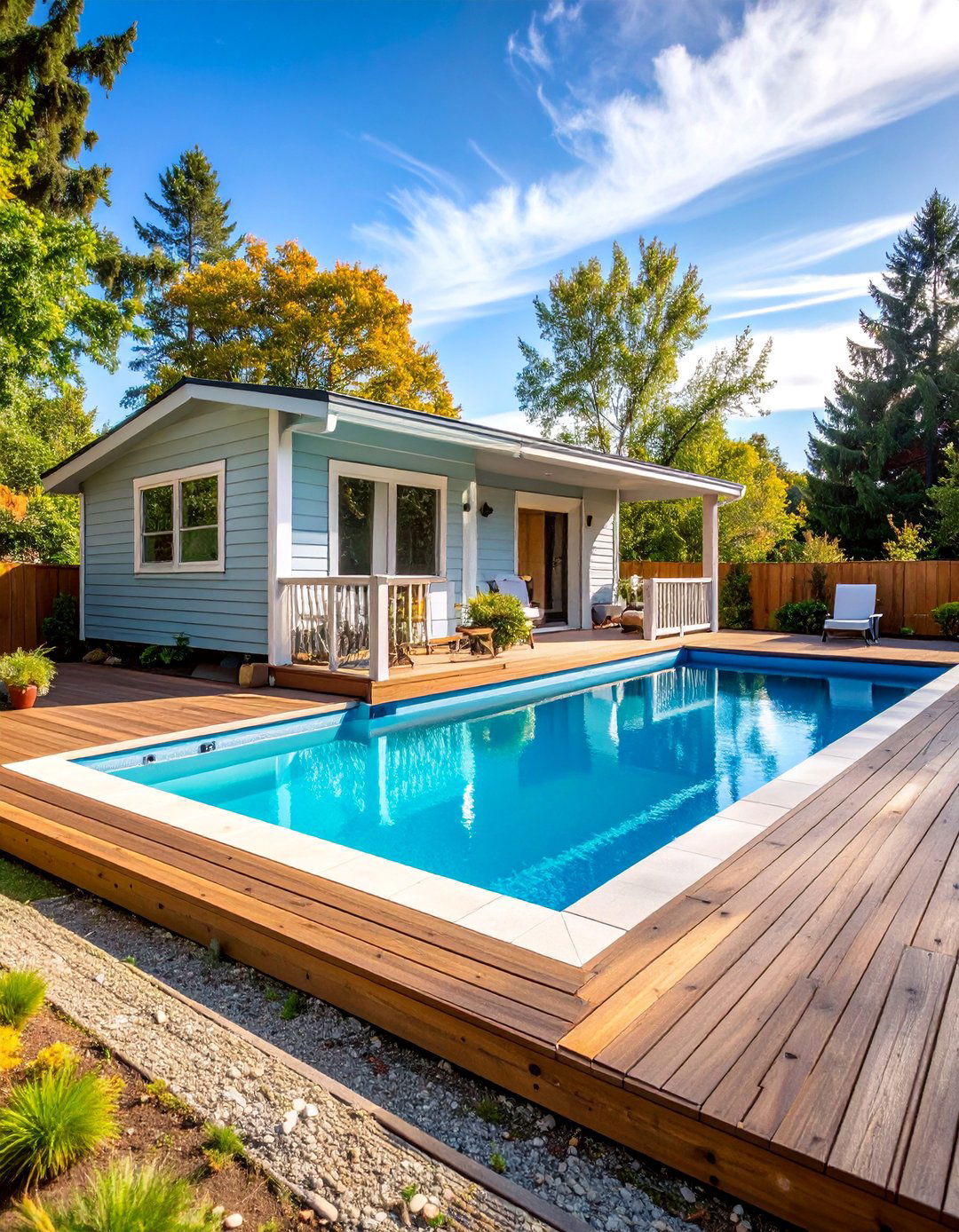





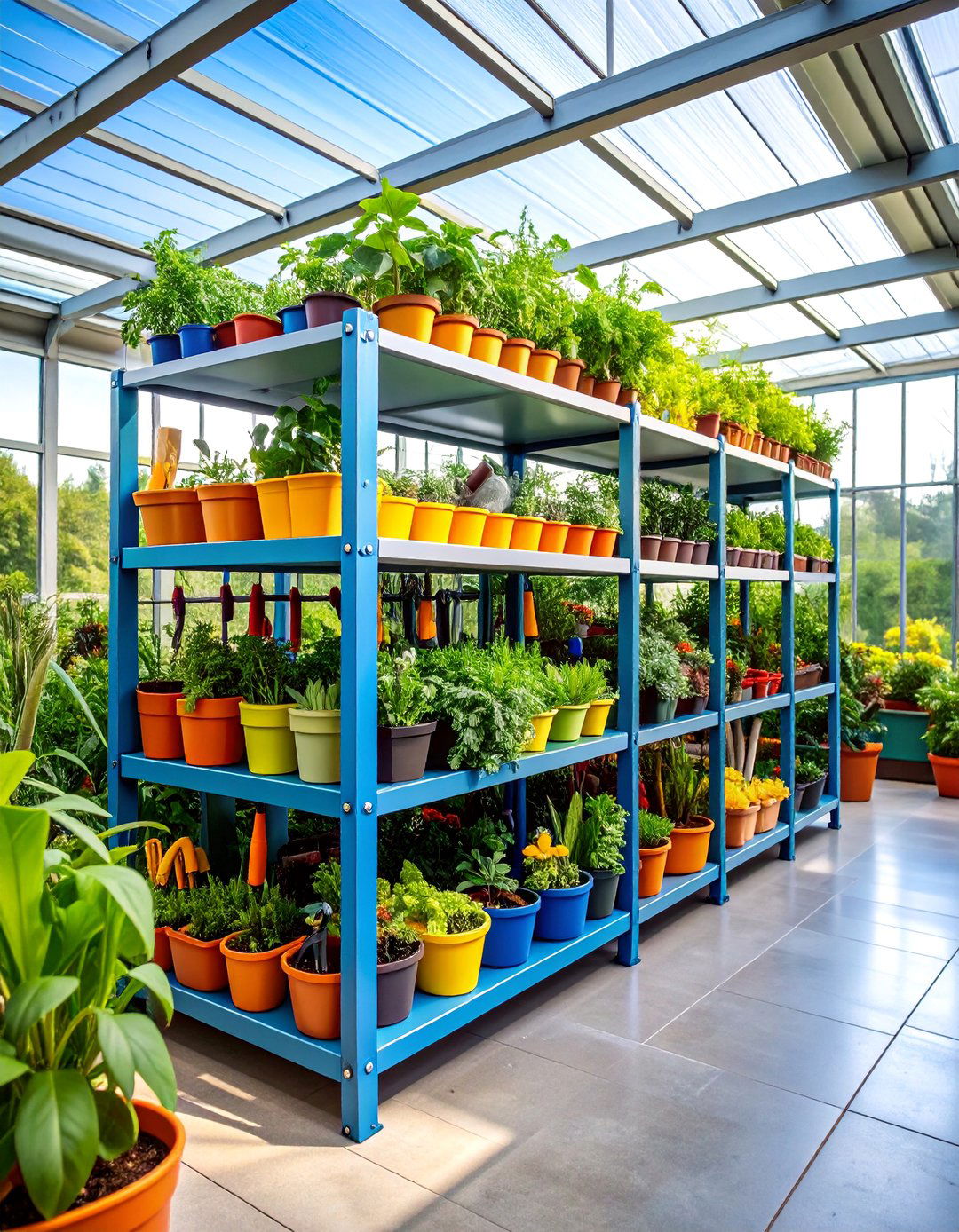
Leave a Reply